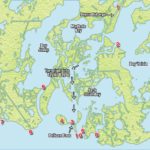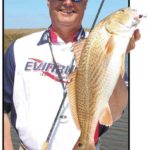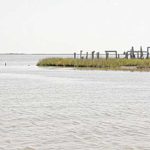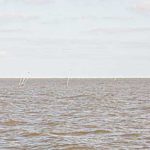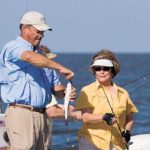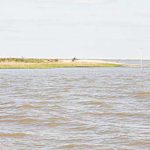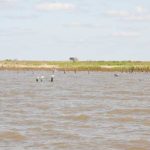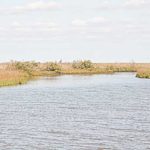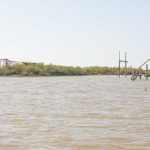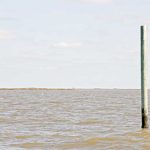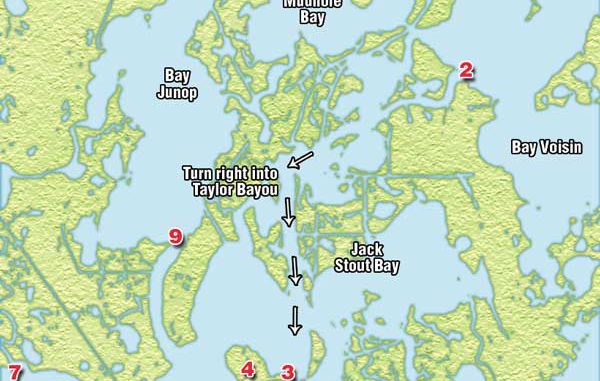
These spots are close, convenient and fish-filled in the month of May.
Folks in Louisiana are used to “passing a good time,” and of those folks wanting to pass a good time on the water this month need to hook up the boat and drive down Highway 315 in southern Terrebonne Parish until the pavement ends.
Launch your boat at Jug Heads right before the levee, and motor down Bayou DuLarge until you come to Taylor Bayou. Take a right into Taylor Bayou, and don’t stop until you get to the Gulf of Mexico and right in the middle of Pelican Pass, where you can pass the best time of your life.
“Last year during the Houma Oilman’s Tournament, we caught 600 trout in four days fishing Pelican Pass,” said Bayou Guide Service owner Capt. Bill Lake. “We mainly caught them two at a time on double rigs. During May and June, there’s no better place to fish down here.”
Lake says Pelican Pass is one of the first areas where the trout show up along the coast every year. It acts as a natural attractant with its huge shell reefs, deep passes, numerous bayous and copious amounts of baitfish and shrimp.
“We always hit Pelican Pass before heading out to the shallow rigs like Mardi Gras,” Lake said. “The only thing is that we usually don’t have to leave Pelican Pass. It saves us a lot of running, and there have been many days when our trip started and stopped right here.”
Besides the large schools of trout that swarm Pelican Pass this time of year, Lake says the presence of 10 spots within about a 2-mile radius means he can spend more time fishing and less time running.
If you’re like Lake, and would rather spend your day with your bait in the water than your hand on the wheel, give these 10 spots a try.
• No. 1: King Lake Pass
N29 15 697 x W90 59 798
On his way down to Pelican Pass, Lake first stops at the mouth of King Lake Pass, the first opening into King Lake as you head south from Grand Pass. Lake says the spot is easy to locate by two camps that line the cut.
“During late April and early May, you’re likely to find shrimp moving through this cut,” Lake said. “No shrimp, no fish. Let the birds dictate whether you stop here or not. If they’re diving, the shrimp are there.”
Although he’s caught plenty fish in the middle of the cut in the deeper water on a rising tide, Lake prefers fishing the King Lake side on a falling tide. He advises being in the cut at the beginning of the falling tide, which will put you all over the trout for an hour or two.
“I like single- or double-rigged LSU Bayou Chubs on 1/4-ounce jigheads,” Lake said. “But Speck-Tacular rigs or Speculizers with the DOA shrimp also work on the trout. Swimbaits are good, too. Also, redfish cruise the oyster banks to the right after you enter King Lake. Throw gold spoons and LSU Chubs to get their attention.”
• No. 2: North Taylor Bayou & King Lake
N29 14 282 x W90 59 767
This spot has historically been a great place for catching speckled trout, but Lake says the addition of a platform that was erected a few years ago has only enhanced the fishing at this popular spot with the shell bottom that surrounds it.
“Lots of current and bait move through this location, and the trout stack up here to feed on the shrimp and tiny crabs,” Lake said. “Look for diving birds as a dead giveaway for the schools of feeding fish.”
Lake likes to drop his trolling motor on calm days to circle the platform until he finds some trout. They usually stack up on the upcurrent side of the platform on either the northeast or northwest corners.
“Don’t forget about fishing the corners of the main mouth of Taylor Bayou itself while you’re here,” Lake advised. “Fish stack up behind the current lines 15 to 20 yards off the points. Double-rigged LSU or glow/chartreuse Bayou Chubs work well, as do popping corks with Chubs or shrimp set about 18 inches under the cork.”
• No. 3: Pelican Pass Reefs
N29 11 050 x W91 01 437
After checking his first two spots, Lake heads down Taylor Bayou toward Pelican Pass at the Gulf of Mexico. The numerous white PVC poles that are scattered throughout the pass let him know that he has arrived.
“Slow down and do not run this area until you learn how the reefs run across the open water,” he cautioned. “This area can be very dangerous on low tide with water depths less than a foot in some places. There is a deep channel that leads to the Gulf, and it is somewhat marked by the PVC pipes, but you can’t count on it because the oystermen constantly move the poles.”
Before the wind picks up, Lake typically starts fishing the reefs with MirrOlure Top Dogs and She Dogs. He likes to fish the edges of the reefs where they drop off into the 12-foot channel. When that bites shuts off, Lake drifts through the pipes in two to three feet of water.
“When I get a hook-up, I drop the Power Pole or drop anchor immediately and fan cast the area until I’m satisfied I’ve fished the area well enough to continue the drift,” Lake explained. “I prefer single LSU Chubs because of the shallow water, but DOA and Billy Bay shrimp work well under a cork.”
• No. 4: Pelican Island
N29 11 050 x W91 01 437
Lake says Pelican Island sticks out like a sore thumb as the large island that defines the west side of Pelican Pass as you move toward the Gulf. The key here is to fish the east and west points of Pelican Island as moving water around these points creates easy ambush points for trout and reds.
“I rarely do well working the middle of the island because the fish prefer the points,” Lake said. “We catch big numbers of trout here during May and June when the water is usually emerald green. The wind has a lot to do with the water quality as it’s all open water.”
Strong south or west winds will muddy the shallow reefs in no time at all. Lake says your best wind is a light southeast wind that will clean up the water and be just strong enough to keep the gnats away.
“You can also drift the open water through the PVC pipes north of Pelican Island into East Bay Junop if it’s calm enough,” Lake added. “I don’t change anything here, and I stay with the single-rig LSU Bayou Chubs and plastic shrimp under a cork.”
• No. 5: Taylor Bayou Cove
N29 10 988 x W91 01 314
Where Taylor Bayou enters the Gulf of Mexico, there is a visible shell bank to the east of the bayou. This cove is very shallow near the shorelines, but it drops into 4 or 5 feet of water farther to the south.
“Redfish and trout gather in this cove throughout the summer feeding mostly on pogies,” said Lake. “This is an excellent topwater area as the cove is protected from north, west and east winds. Look for signs of baitfish flipping on the surface.”
Reds often cruise the shoreline here and can be spotted tailing on calm days, and he’s witnessed big schools of bull reds running mullet against the shallow banks. Lake likes to throw gold spoons to the tailing reds, but it’s the 18- to 20-inch trout that demand most of his attention.
“Other than the topwaters, the trout will take single-rigged LSU and avocado/red Bayou Chubs in this cover,” Lake said. “The south point located on the east side of the cover can be really good.”
• No. 6: Bayou Giro Rock Dam
N29 10 972 x W91 03 733
Heading west along the shoreline from Pelican Island, Lake says you’ll run into a rock dam with a huge pipe sticking high above the dam. If the water is good and green here, Lake cautioned anglers to never pass this area up without making a few casts.
“Trout and redfish love this spot,” he added. “When the shrimp are running, this is an excellent place to catch limits of both. Redfish hold tight to the rocks while trout tend to be 15 to 20 yards off the rocks.”
The water off this rock dam is so shallow that Lake says trolling the area quietly is a must to keep from spooking the fish. As he trolls the dam looking for some bites, Lake immediately drops his Power Pole when he gets a couple fish in the boat.
“I like the double rigs here,” he said. “And I’ve doubled up a number of times while fishing this spot. But the swimbaits are awesome, too, because the trout here eat pogies. Croaker, blue/black, limetreuse and glow colors work best.”
• No. 7: Mouth of Bayou Giro
N29 11 439 x W91 05 070
Maybe a mile to the west of the pipeline rock dam is Bayou Giro, which runs all the way from Hellhole Bay south to the Gulf of Mexico. Right at the mouth where it enters the Gulf is a shallow flat that has been built up from sediment from the bay.
“A falling tide is best to fish this area, as I’ve never caught fish here on a rising tide,” Lake said. “The falling tide empties the bay, and everything comes down the bayou to the Gulf. The flats at the mouth of the bayou hold good numbers of hungry trout.”
While trout could be just about anywhere at the mouth of Bayou Giro, Lake says there is a bar that extends about 100 yards from the mouth, and that’s where the fish are most days. If you have trouble finding it, just look for the diving birds.
“I found a small trough between that bar and the actual channel last year, and that’s where I caught most of my fish two at a time on double rigs,” Lake said. “One thing I noticed, though, was that we had to pull the double rigs the same direction as the current. There is also a small run-out to the right in the first curve going up the bayou that holds redfish.”
• No. 8: Jack Stout Bayou
N29 10 980 x W91 00 812
After working toward the west of Taylor Bayou, Lake moves to the east of it to hit Jack Stout Bayou. Hardly noticeable, it is recessed way back in a small cove, and it is best on a falling tide that isn’t pulling too hard.
“This bayou drains Jack Stout Bay,” Lake said, “and all the shrimp and baitfish funnel south through this spot to the Gulf. I like fishing here on days with about a 0.4 to 0.6 tidal range. That’s just enough to make the fish feed.”
Expect to lose some lures here because the bottom is dirty with oyster shells, and there is an old sunken boat about 150 yards out in the mouth of the bayou that attracts lots of 2-pound trout.
“It’s best to use a popping cork around the perimeter of the boat as you’ll lose a lot of stuff fishing the bottom,” Lake added. “Other than the boat, work every inch of this cove to catch your fish. Some days they’re up shallow, and some days they’re out in the middle.”
• No. 9: Bayou DeWest
N29 12 524 x W91 03 106
Bayou DeWest runs from Bay Junop south to East Bay Junop, and it is a deep bayou with lots of current. Lake says bull-red fishing is really good on the north and south ends of the bayou, but it’s most noted for its great trout fishing on the south side as it enters East Bay Junop.
“I generally look for diving birds or birds just sitting on the water,” Lake said. “Large slicks are also quite common when the fish feed on shrimp or pogies. Early May is a great time to fish that area just before the bay shrimp season gets underway.”
Although he likes it before shrimp season, Lake says the shrimp boats won’t mess it up too bad because they skim off the surface rather than drag the bottom, which would muddy up the entire area.
“Double-rigged Bayou Chubs and Chubs under popping corks are all I use at this location,” Lake said. “And drifting is the key to my success. Don’t start your big motor unless you’re ready to try another spot. Sometimes you have to drop anchor to keep other boats from moving in on you because this is a very popular spot.”
• No. 10: Taylor Bayou Channel Marker
N29 11 050 x W91 01 437
A lone piling marks the end of Taylor Bayou where it enters the Gulf of Mexico. Lake says this is the spot for you if you love big redfish. The hole around this pole is deep, and the bull reds are there most days.
“Moving current is all you need,” he said. “It doesn’t matter which way it’s going either. I usually tie up to the pole and fish in the direction of the moving tide.”
Lake says anglers can reasonably expect to catch reds from 8 to 25 pounds in this spot. Rat reds are not very common, as most of the fish are over 27 inches. Lake catches the smaller reds when the tide isn’t moving very hard.
“Live crabs or croakers fished on a Carolina rig is best at this spot,” Lake said. “It’s kind of a no-brainer. As the reds migrate in from the open Gulf into Taylor Bayou, they move through this spot, which is the deepest waterway in the area.”
Contact Capt. Bill Lake at 985-851-6015.
